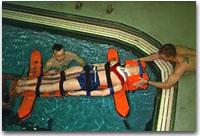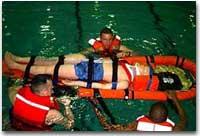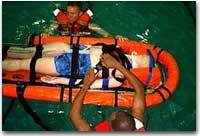October 1, 2016 Spinal Injury Management in Deep Water
by Gerald M. Dworkin
February 11, 1998



The following article was developed at the request of the University of Bath Lifeguards and has been posted to provide information for lifeguard and other Water Rescue personnel. The procedures outlined demonstrate the recommended procedures when working from a pool deck. These procedures can also be used in a deep water situation while working from a rescue boat. During open water rescue incidents, we also recommend the use of a flotation basket stretcher as demonstrated within this article.
After the patient is rescued from the bottom or from a prone (face down) position, the initial rescuer should maintain in-line stabilization of the patient’s head and neck while moving the patient to the corner of the pool. A 2nd rescuer, lying prone on the deck should receive the patient and take over in-line stabilization while the first rescuer then concentrates on keeping the patient in a horizontal plane with one hand while maintaining his position in the water by holding onto the deck with the other hand.
Additional rescuers would then be required to (a) size and apply a cervical collar, (b) place the backboard under the patient, and (c) immobilize the patient to the backboard. These procedures can easily be performed while the rescuers are on the deck, or in the water using the side of the pool for support, or by using rescue tubes for buoyancy. The use of two rescue tubes placed under and across the shoulder and foot sections of the backboard will assist in providing a good stable flotation platform for the backboard and patient while the rescuers are immobilizing the patient. After the patient is fully immobilized via the appropriate strap system, the head would then be immobilized using a commercial cervical immobilization device (C.I.D.) or by any other acceptable means. When the rescuers remove the immobilized patient from the water, the rescue tubes would be removed first. (refer to Photo A)
The use of a flotation basket stretcher can also be used very effectively, especially in open water rescue incidents. Once the patient is effectively immobilized onto the backboard, the patient is then transferred into the basket stretcher by submerging the foot section of the basket stretcher and moving the patient and backboard via a long axis drag into the flotation basket stretcher. Once the immobilized patient is in the basket stretcher, he/she should be secured via the use of the basket stretcher straps prior to being moved or transferred into the rescue boat. (refer to Photo B & C)
These skills should be practiced and mastered by all Lifeguard and Water Rescue personnel using a training manikin prior to performing these skills on live victims in actual incidents. Thanks are extended to Marine Combat Water Survival Instructors Sgt. Dan Jansen and Sgt. James Clark, and to Lt. Jerome Williams of the Fairfax County Fire and Rescue Department for their assistance in this article.


